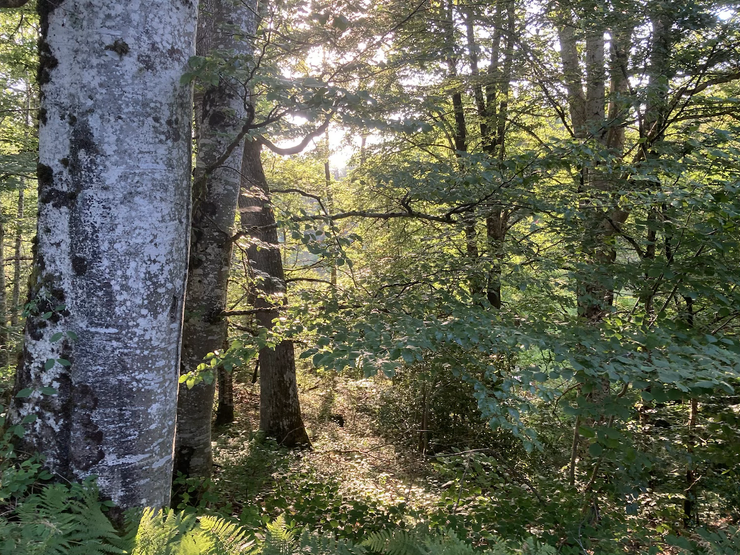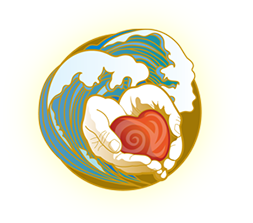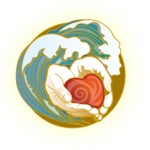Please visit Sophie Rieu’s website for more wonderful blogs: https://www.mycraniosacrallife.com/blog
Bodies speak to us, biodynamic craniosacral therapists, in the most peculiar language, a vernacular we learn as we steep in the rhythms and dances of tissues and fluids, and relate to the potency of their respiration.
The first time I placed my hands on someone’s ankles as part of a practice session, our tutor Colin Perrow invited us to pay attention, to notice any figure, image, shape, smell or any sensation we felt. I remember distinctly that a ‘parabolic highway with a slight curve at the top’ came to my perceptive field and I had no clue what it was.
Colin encouraged me to draw it and I duly did. A few months later as we were studying the viscera, there it was that exact outline: the peritoneum, the fascia protective suit or membrane surrounding our gut, liver, stomach, spleen, gallbladder and pancreas.
I was dumbstruck, and I will never forget Colin’s words: “Trust your intuition. Trust what you see and feel” and I’m paraphrasing here but he would add that no matter how outlandish the image, the scent, the sensation trust it. Listen to it.

(photo courtesy of Elise Desmet)
This was our first seminar and it was the perfectly right moment to tell us this, to entice us away from over relying on our cerebral cortex and our intellect, the one part of us that is so overstimulated from our days in school.
Reasoning and learning have their place but I soon realised that in our practice, intuitive and instinctive awareness are essential. They communicate with our intellect in a holistic manner, like equally important parts of a whole, and they reinforce and reinvigorate one another.
It is so easy to doubt one’s intuition when our educational system is so hooked on the reasoning mind and we are taught from a young age to disbelieve what is not tangible.
Colin would also explain how he could ‘see’ what was unfolding beneath the skin, it just came to him in different ways that he was opened to receiving.
I was fascinated by what at first felt like supernatural abilities. But as I continued on this path, I realised that far from being ‘airy fairy’ this sensuous perception is deeply anchored in the tangibility of the body.
It is a form of deep listening to a world of signs, symbols, images and sensations that craniosacral practitioners learn to ‘track’ and decipher by immersing themselves into a contact with bodies that is at once very gentle and respectful of boundaries and yet extraordinarily perceptive and gifted with astounding acuity.
When asked about this experience, Ryan Halford of the Craniosacral podcast (1) also speaks about the natural kinship we develop with the forms of the body and their language:
“I know what a liver is because I speak its language. I know its form. I know where it came from, and I know what it seeks to do in the body. I’ve spent time with many livers over a span of decades, so we have some familiarity.”
“When I am awake and attentive, the client’s body speaks to me and tells me important stories that have been locked away, hidden … unacknowledged. Healing brings the light of consciousness to these stories. They emerge through shapes, shifting tensions, wave forms, vibrations, memory, emotional tone, and many other variables that permeate the fluids, membranes, and ether of the body space. It is endlessly fascinating and beautiful … an ongoing saga of humanity’s struggle to find balance and peace.”
We track the unseen and this unseen speaks to us from a particular perspective as we remain as neutral as possible in our non-doing.
I quite like French philosopher Baptiste Morizot’s reference to animal trackers as “diplomats towards the living” with “relational powers” that are used to “dive irremediably among them, in their midst.” (2)

(photo courtesy of Elise Desmet)
A craniosacral therapist in many ways is also this diplomat endowed with what may seem to the neophyte incredible ‘powers’ but which are really everyone’s “birthright” as Ryan adds.
Another BCS practitioner, Scott Zamurut (3) says that, “Specialized perception is an inherent capacity of human beings, and it can be cultivated through practice, training, and the clearing of interfering obstacles. Just as a wine sommelier can identify the county or village in France where the grapes for a particular vintage are grown, we as Biodynamic practitioners can cultivate a perception of the various anatomical terrains of body physiology to a very fine degree.”
A diplomat immersing himself and ‘seeing’ with the eyes of the creature they track, adjusting their perception to sense from another’s perspective. As Ryan Halford explains:
“Most of us living in modern civilizations are out of touch with our capacity for deep sensing. We don’t really need access to our deepest organic senses because so many of life’s basic needs are provided to us fairly easily. When we go out into nature and experience the wildness of the world we begin to get back in touch with our more primitive capacities. It is there in nature that we are reminded of our capacity to feel in layers and see the underlying movements of consciousness through space. We notice subtleties that provide clarity, enabling us to better understand what is within us and around us. It is our natural state to see clearly.”
I have taken to tracking in the nearby forest after training with professional tracker Lucy O’Hagan (4), and noticed how, like in a craniosacral session, there is a natural ‘decentering’ occuring in that “I” becomes part of a multirelational universe whereby I listen to the signs, the ‘invisibles’ and it is as if I were ‘in the body’ of the animal I track while at the same time I listen to what my own body feels and to the surrounds, the plants, the trees, the wind, the scents, the soil. The tracker becomes part of a constellation of symbols they can ‘read’.

(photo courtesy of Lucy O’Hagan, look closely you will see a badger)
Morizot speaks about “awakening the eye of the spirit” that many indigenous tribes refer to.
Teacher and BCS practitioner Margaret Rosenau (5) says: “I remember the first time I saw the Grand Canyon in someone’s spine. The recognizable span of space between vermillion cliff walls, the blue of the Colorado River far below. The Grand Canyon was teaching me about potency, showing me that the potency had retreated in this person, like the river far below. My first impulse was to convince the potency to rise towards me. But the canyon said no, descend. Go to the place where the potency is. Don’t ask it to come to you. Don’t convince it to do anything. This person has already done that for too long. Be with their depletion. Deal with your discomfort. Know their Health is present, recognize that their potency is still available. Recognize the potential wherever it is and magnify it. Exhale. Nothing is yours to fix. Everything is already whole.”
This “awakening of the eye of the spirit” is what Colin Perrow was talking about without using the same words: allowing an adventurous mapping, one that has never been done before each and every time we hold a new living organism.
A mapping that brings the Grand Canyon to Margaret or that sends the Milky Way to my inner eye, as the spiralling galaxies I often see in bodies tell me of a return of Health expressing along midlines or in places that once were inertial fulcra.
This perception feels extraordinary in a profoundly disconnected world but it is ‘normal’ to indigenous tribes who are at one with the land and ‘dream’ it with ease.
I am forever an apprentice of the bodies I hold. I trust my intuitive and instinctive awareness more and more each time and I am astounded by the ‘results’.
As Ryan says, “Craniosacral therapists are some of the most extraordinary people on the planet. Not only do we stay in regular contact with the constantly-shifting material landscape of biology, organic life, and space itself through our senses, but we do it from a place of stillness and neutrality. This life path facilitates the re-emergence of our deep natural capacities, which are the birthright of all of humanity. This birthright, sadly, is forsaken by the vast majority of people. We are so lucky to be on this professional path of inquiry, for it brings an increasingly vivid experience of life.”
I am in a constant state of awe when I hold a body whose Health speaks to me fluently. I fall in love with the multiplicity of dances and the diversity of unfoldings I witness.

We are drawing from the deep and ancient well of co-evolution with the living and biodynamic craniosacral therapy is an incredible path that can lead us back to our true nature.
Margaret speaks of this consistency, “For many years now, the Grand Canyon comes in into my inner vision whenever a client’s body wants to show me the depletion of its potency. I teach my students what the canyon taught me to do. I teach my students to trust what they see, to know that this kind of sight is part of Craniosacral Therapy and is not just limited to it. I remind them that the kind of knowing and seeing and listening that we do as practitioners of BCST are ancient skills that have been dismissed or buried. But they are not gone. They are right here at our fingertips, in our hands, behind our eyes. They have always been there. It’s time to get to know them and trust them, recognize their and your potential and magnify it. Exhale. Nothing is yours to fix. Everything is already well.”
This trusting the signs has been my guide and my teacher throughout my practice. As Margaret says there is nothing to fix, the organism’s Intelligence is the one in charge, the one that communicates with me throughout sessions. I also call it my mentor sometimes. It knows what I don’t and often mirrors in my own body what my client feels.
I share with my clients what I feel about a very specific emotional charge or pain, clearing, tension, physiological shift and they invariably confirm what I pinpointed to them. It is such a precious gift and creates such an ineffable bond between practitioner and client, and this mysterious Intelligence that is everywhere in and around us.
Through each body’s expression of this universal Intelligence I also receive details of morphology ( I prefer the word morphology to anatomy for a living organism) that inform my facilitation and will engage my perception in a particular way.
For example fascia ‘conduction’ and connection recently communicated to me that a misalignment in the hip of my client was related to a tilting of her jaw. This client confirmed that she had had ongoing jaw and teeth ‘problems’ and had been suffering from an ongoing discomfort in the left hip that could become severely painful whenever she would exercise.
As my whole body holding adjusted to include this information I could feel the left hip open while the right softened and slowly began to balance.
I could ‘see’ as well as feel the protuberance of the iliac crest on the right side adjust downwards while its rigidity dissipated. It even felt less ‘sharp’ to my perception. I also felt the ‘swelling’ on her left hip and the tension in her left shoulder and left side of her neck subside gradually as reconnection along the midline took place.
Soon after this was initiated I felt her jaw’s relief at being held and supported while it began to realign and set off a whole body reorganisation.
Scott Zamurut explains that, “The continually unfolding discoveries in the study of fascia point to the capacity for our fascial body to transmit information and energy which, along with the rich enervation of our fascial body, may account for a portion of our perceptual sensing in session work.”
He relates that, in a recent experience,”While holding a client’s sacrum towards the completion of a session I felt there was still something more her system needed to accomplish. As I sat I became aware of the denticulate ligaments of her pia mater. At first all that came was a knowing, and the words “denticulate ligaments.” Then an image of them appeared in my inner eye (these images often look like Dr. Netter’s paintings), with an embodied sense that I was in touch with this anatomical terrain in her system. Then I felt her system “washing the shock out” of her denticulate ligaments (thanks to Dr. Becker for his description of shock being washing out of tissue by the Breath of Life). Specificity of perception supports healing in a clear and precise manner”.
In many ways it is a pity that it should be seen as extraordinary because it places craniosacral therapy in a particular ‘niche’ and prevents the mainstream ‘medical’ paradigm from acknowledging the fantastic contributions BCST makes to literally changing people’s lives for the better.
But I take solace in the fact that as we impart our intuitive and instinctive knowledge to our clients, inviting them to re-embody safely while checking in, sharing what we perceive and encouraging them to trust what their awareness is telling them, this becomes part of their living routine, thus re-igniting skills we have been granted since our hunter gatherer ancestors began to hone their tracking cognitive powers.

Notes and references:
1- Ryan Halford is a teacher and BCST practitioner based in Texas. He is the creator of the famous craniosacral podcast see: https://www.craniosacralpodcast.com/
2- Baptiste Morizot, Sur la Piste Animale or On Animal Tracking, Actes Sud, 2018.
3- Scott Zamurut is a teacher and BCST practitioner based in New Mexico, see www.scottzamurut.com
4- For more on what Lucy O’Hagan offers see www.wildawake.ie
5- Margaret Rosenau is a teacher and a BCST practitioner based in Denver, Colorado, see https://www.schoolofinnerhealth.org/

